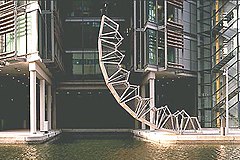The Rolling Bridge
 Half uncurled | |
| Ancestor | truss bridge |
|---|---|
| Related | None |
| Descendant | none |
| Carries | Pedestrians |
| Span range | short |
| Material | Triangular steel segments, hydraulic actuators, lightweight deck |
| Movable | Yes |
| Design effort | high |
| Falsework required | No |
The Rolling Bridge (also known as "the curling bridge"), is a new type of bridge constructed by the English designer Thomas Heatherwick, in 2004 as part of the refurbished Grand Union Canal office & retail development project at Paddington Basin, London.
This bridge consists of eight triangular sections hinged at the walkway level and connected above by two part links that may be collapsed toward the deck by hydraulic pistons, which are concealed in the handrails of each section. When extended, it resembles a conventional steel and timber footbridge, and is 12 metres long. However, to allow the passage of boats, the bridge can be made to curl up until its two ends touch, to form an octagonal shape covering one half of the waterway's width at that point.
The Rolling Bridge is curled up every Friday at noon.
In 2005, the bridge won the 2005 British Structural Steel Award (awarded by British Steel.

See also
- Rolling Bridge official site (www.heatherwick.com)
- 2004 photo - bridge in closed position
- 2004 photo - bridge opening
- 2004 photo - bridge in open position
- Movable bridge for a list of other movable bridge types
